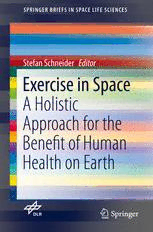
Exercise in Space: A Holistic Approach for the Benefit of Human Health on Earth PDF
Preview Exercise in Space: A Holistic Approach for the Benefit of Human Health on Earth
SPRINGER BRIEFS IN SPACE LIFE SCIENCES Stefan Schneider E ditor Exercise in Space A Holistic Approach for the Benefi t of Human Health on Earth 123 SpringerBriefs in Space Life Sciences SeriesEditors Gu¨nterRuyters MarkusBraun SpaceAdministration,GermanAerospaceCenter(DLR),Bonn,Germany More information about this series at http://www.springer.com/series/11849 Stefan Schneider Editor Exercise in Space A Holistic Approach for the Benefit of Human Health on Earth Editor StefanSchneider GermanSportUniversityCologne Cologne,Germany ISSN2196-5560 ISSN2196-5579 (electronic) SpringerBriefsinSpaceLifeSciences ISBN978-3-319-29569-5 ISBN978-3-319-29571-8 (eBook) DOI10.1007/978-3-319-29571-8 LibraryofCongressControlNumber:2016938910 ©TheAuthor(s)2016 Thisworkissubjecttocopyright.AllrightsarereservedbythePublisher,whetherthewholeorpartof the material is concerned, specifically the rights of translation, reprinting, reuse of illustrations, recitation, broadcasting, reproduction on microfilms or in any other physical way, and transmission or information storage and retrieval, electronic adaptation, computer software, or by similar or dissimilarmethodologynowknownorhereafterdeveloped. The use of general descriptive names, registered names, trademarks, service marks, etc. in this publicationdoesnotimply,evenintheabsenceofaspecificstatement,thatsuchnamesareexempt fromtherelevantprotectivelawsandregulationsandthereforefreeforgeneraluse. Thepublisher,theauthorsandtheeditorsaresafetoassumethattheadviceandinformationinthis book are believed to be true and accurate at the date of publication. Neither the publisher nor the authors or the editors give a warranty, express or implied, with respect to the material contained hereinorforanyerrorsoromissionsthatmayhavebeenmade. Printedonacid-freepaper ThisSpringerimprintispublishedbySpringerNature TheregisteredcompanyisSpringerInternationalPublishingAGSwitzerland Preface to the Series The extraordinary conditions in space, especially microgravity, are utilized today not only for research in the physical and materials sciences—they especially provide a unique tool for research invarious areas ofthe life sciences. The major goal of this research is to uncover the role of gravity with regard to the origin, evolution, and future of life and to the development and orientation of organisms from single cells and protists up to humans. This research only became possible withtheadventofmannedspaceflightsome50yearsago.Withthefirstexperiment having been conducted onboard Apollo 16, the German Space Life Sciences Program celebrated its 40th anniversary in 2012—a fitting occasion for Springer and the DLR (German Aerospace Center) to take stock of the space life sciences achievementsmadesofar. TheDLRistheFederalRepublicofGermany’sNationalAeronauticsandSpace ResearchCenter.Itsextensiveresearch anddevelopmentactivitiesinaeronautics, space,energy,transport,andsecurityareintegratedintonationalandinternational cooperative ventures. In addition to its own research, as Germany’s space agency theDLRhasbeenchargedbythefederalgovernmentwiththetaskofplanningand implementing the German space program. Within the current space program, approved by the German government in November 2010, the overall goal for the life sciences section is to gain scientific knowledge and to reveal new application potentialsbymeansofresearchunderspaceconditions,especiallybyutilizingthe microgravityenvironmentoftheInternationalSpaceStationISS. With regard to the program’s implementation, the DLR Space Administration providestheinfrastructureandflightopportunitiesrequired,contractstheGerman space industry for the development of innovative research facilities, and provides the necessary research funding for the scientific teams at universities and other researchinstitutes.Whileso-calledsmallflightopportunitieslikethedroptowerin Bremen,soundingrockets,andparabolicairplaneflightsaremadeavailablewithin the national program, research on the International Space Station ISS is implementedintheframeworkofGermany’sparticipationintheESAMicrogravity Program or through bilateral cooperations with other space agencies. Free flyers v vi PrefacetotheSeries such as BION or FOTON satellites are used in cooperation with Russia. The recently started utilization of Chinese spacecraft like Shenzhou has further expandedGermany’sspectrumofflightopportunities,anddiscussionsaboutfuture cooperationontheplannedChineseSpaceStationarecurrentlyunderway. From the very beginning inthe 1970s, Germany has been the driving force for humanspaceflightaswellasforrelatedresearchinthelifeandphysicalsciencesin Europe.ItwasGermanythatinitiatedthedevelopmentofSpacelabastheEuropean contributiontotheAmericanSpaceShuttleSystem,complementedbysettingupa sound nationalprogram.And today Germany continuestobe the major European contributortotheESAprogramsfortheISSanditsscientificutilization. For our series, we have approached leading scientists first and foremost in Germany, but also—since science and research are international and cooperative endeavors—inothercountriestoprovideuswiththeirviewsandtheirsummariesof the accomplishments in the various fields of space life sciences research. By presenting the current SpringerBriefs on muscle and bone physiology, we start theserieswithanareathatiscurrentlyattractingmuchattention—dueinnosmall part to health problems such as muscle atrophy and osteoporosis in our modern ageing society. Overall, it is interesting to note that the psychophysiological changes that astronauts experience during their spaceflights closely resemble those of ageing people on Earth but progress at a much faster rate. Circulatory and vestibular disorders set in immediately, muscles and bones degenerate within weeks or months, and even the immune system is impaired. Thus, the ageing process as well as certain diseases can be studied at an accelerated pace, yielding valuable insights for the benefit of people on Earth as well. Luckily for the astronauts: these problems slowly disappear after their return to Earth, so that their recovery processes can also be investigated, yielding additional valuable information. Bookletsonnutritionandmetabolism,ontheimmunesystem,onvestibularand neuroscience,onthecardiovascularandrespiratorysystem,andonpsychophysio- logicalhumanperformancewillfollow.Thisseparationofhumanphysiologyand space medicine into the various research areas follows a classical division. It will certainlybecomeevident,however,thatspacemedicineresearchpursuesahighly integrativeapproach,offeringanexamplethatshouldalsobefollowedinterrestrial research.Theserieswilleventuallyberoundedoutbybookletsongravitationaland radiationbiology. We are convinced that this series, starting with its first booklet on muscle and bonephysiologyinspace,willfindinterestedreadersandwillcontributetothegoal of convincing the general public that research in space, especially in the life sciences,hasbeenandwillcontinuetobeofconcretebenefittopeopleonEarth. Bonn,Germany Gu¨nterRuyters Bonn,Germany MarkusBraun July,2014 PrefacetotheSeries vii DLRSpaceAdministrationinBonn-Oberkassel(DLR) TheInternationalSpaceStationISS;phototakenbyanastronautfromthespaceshuttleDiscovery, March7,2011(NASA) viii PrefacetotheSeries Extravehicular activity (EVA) of the German ESA astronaut Hans Schlegel working on the EuropeanColumbuslabofISS,February13,2008(NASA) Foreword After the publication of the first two volumes of this series on musculoskeletal problemsinDecember2014andonnutritionphysiologyandmetabolisminspring 2015, respectively, we now present the next volume on the topic of “Exercise in Space—aholisticapproachforthebenefitofhumanhealthonEarth”.Asispointed outbytheauthors,humanhabitatsinspacesuchastheInternationalSpaceStation ISS represent very special cases of extreme living conditions. However, similar isolatedandstressfulconditions—exceptmicrogravity,ofcourse—prevailalsoon Earth,e.g.,inAntarcticstations,submarines,andotherextremeenvironments.All thesespecialconditionschallengenotonlythephysiologicalsystemsofthehuman body but also the psychological system. Exercise has positive effects on both. In this sense, development of new exercise countermeasures for astronauts together with accompanying scientific research is also beneficial for physiological and mental health care on Earth especially for the ageing society of the industrialized countries. In a highly interdisciplinary and integrative approach, the authors describe in five chapters the challenges of physiological and psychological systems provoked byextremeconditionssuchastheonesprevailinginspace.Sinceexerciserequires certain motor skills,thebookletstartswithadescriptionofthedeficitsthatmotor skills experience in microgravity and advertises mental training as a countermea- sure. In the second chapter, the adaptation of cartilage to immobilization—pro- voked bybedreststudies,inbedriddenpatients,orinspaceflight—isinvestigated. This is a highly neglected topic also in medicine on Earth, although healthy cartilageisessentialfortheunconfinedfunctioningofthemusculoskeletalsystem. Again,humanspaceflightprovidesauniqueopportunitytostudythesechangesthat normallyoccurovermonthsandyearsonEarthsotosayintimelapsewithinafew weeks in microgravity. The following chapter concludes the pure physiological aspectsofthebookletbydescribingtheregulationofthecardio-respiratorysystem, asystemcriticalforthebody’sworkcapacity.Especially,theeffectsofmicrograv- ityonaerobiccapacityinthecontextofexerciseareinthecenterofinterest. ix
